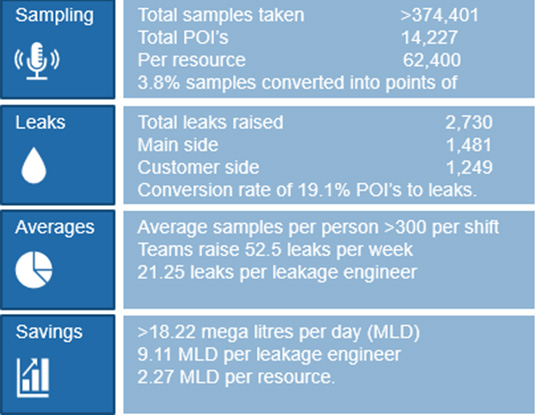Case Studies

Case Study in Brescia, Italy: Estimated savings of 1.4 million cubic meters of water and €560,000; Estimated reduction of 504,000 kg GHG emissions
A2A Ciclo Idrico, a subsidiary of Italy’s largest multi-utility A2A S.p.A. It operates more than 3,000 kilometers of iron water pipes, serving citizens in the municipalities of Brescia and neighboring towns in the northern Italian region of Lombardy. It is part of A2A S.p.A. which is the largest multi-utility in Italy with more than 12,000 employees and 6.5B EUR in annual revenues. A2A distributes renewable energy, electricity, gas, and water and collects wastewater. A2A has embarked on an intensive effort to reduce its water losses and energy costs. They retained the services of AQS (Aquarius Spectrum) in 2019 to conduct a pilot test of their Continuous Correlating Acoustic Monitoring (CCAM) system. This pilot was conducted in September 2019 and entailed the installation of 39 below-ground acoustic sensors that covered approximately 15 km of pipe. During the first week the system was installed, 10 non-surfacing, hidden, leaks were identified. One of these leaks was very large and burst above ground within a few hours of detection. Based on this successful proof of concept study, A2A implemented a full-scale program using the Aquarius Spectrum system.
The Methodology
AQS provides advanced leak detection and in-depth analysis based on fixed base and mobile acoustic sensor systems combined with AI and big data analytics algorithms. The monitoring systems are pipe-type agnostic and can be installed above or below ground. AQS sensors collect daily audio samples and correlation is performed between every two coupled sensors. When a leak noise is detected in the same area an alert is generated with the exact location of the leak. Field crews are then deployed to pinpoint the leak so it can be repaired.
A2A decided to install sensors in the town of Brescia. Brescia is the second largest city in the region, with a population of 200,000 and over 1.5 million people living in its metropolitan area. The sensors were installed in two areas: the city center and in a suburban zone. The sensors in the city center were installed on 48 km of pipeline in the fall of 2020. A total of 147 sensors were installed. The sensors in the suburban areas were installed in the spring of 2022. The 93 sensors in this area covered 31 km of pipeline. During the study period, a total of 134 leaks were detected in the city center and 36 leaks were found in the suburban areas.
The entire project was carried out with the support of Pipecare Italia, Aquarius Spectrum’s partner in Italy. As a trusted service supplier to A2A Ciclo Idrico, Pipecare provided valuable engineering expertise, fleet management, and data analysis. Their commitment to innovating the water sector and reducing water losses has been evident in their thorough oversight of the on-site implementation of this project, ensuring both robust maintenance and uninterrupted service.
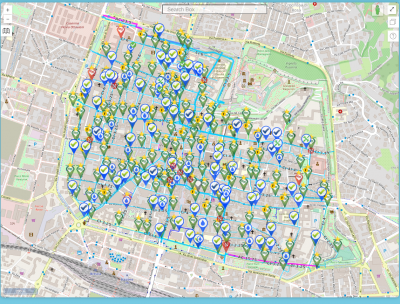
The Benchmark
To evaluate the technical efficacy and value proposition of the AQS system a benchmark must be developed. Fixed base CCAM systems are permanently installed and collect data continuously. The more pipe length that is covered and the longer the sensors are installed all have a bearing on how well the systems functions. It is not adequate to only count the number of leaks found. This does not consider how long they have been active.
CCAM systems detect existing leaks typically as soon as they are installed. The benefit is accrued over time as newly formed leaks are detected and repaired. It is also critical to know how many km of pipe the systems are monitoring. The more pipeline the sensors are monitoring the more leaks will be found. Therefore, a performance metric that takes into account the number of sensors, time deployed and length of pipe cover must be developed to evaluate the value of the system and to be able to compare it to other systems and other projects. The performance metric used herein is leaks detected per 100km per year; leaks/100km/year. For smaller installations this can be reduced to leaks per km per year.
Performance and Results
In the Brescia project the city center sensors have been installed and active for a 36-month continuous period. In the suburban areas they have been active for 18 months. This equates to a performance metric in the city center of 93 leaks per 100km per year and in the suburban area of 75 leaks per 100km per year.
| AQS LEAK DETECTION PERFROMANCE | ||||
| Leaks | KM | Time | L/100KM/Year | |
| City Center | 134 | 48 | 36 months | 93 |
| Suburban | 36 | 31 | 18 months | 75 |
This is an exceptional performance as the system appears to be able to detect all the leaks occurring in the areas covered by the sensors. It has been reported that in Italy, when once year traditional leak detection programs are implemented, one leak per 1.5 km are found. This equates to a performance metric of 67 leaks per 100km per year. The results obtained in this project are 10 – 50 % higher than this. The AQS system can detect small leaks from inception through the time they are large enough for the utility to deploy a crew to pinpoint the leak and repair it. The AQS system can detect very small leaks and track their progression through its algorithm and dashboard.
The 170 leaks that have been found by the AQS system over the time period analyzed have a number of positive value propositions. The average leak size in this study is estimated to be 16l/minute and it is assumed that each leak would last for 12 months if no pro-active leak detection program was in place. The estimated leak life would be one year as well if a utility performed traditional leak detection programs that inspected the same pipe section once a year. This equates to a total estimated volume of water saved of 1.4 million cubic meters per year. At a cost of water production of 0.4 EUR per cubic meter, A2A estimated saving is 560,000 EUR. A total of 360 g of GHG is generated per cubic meter of water delivered. The repaired leaks reduce the GHG emissions by 504,000 kg per year and the amount of energy used by 1 million KWh per year.
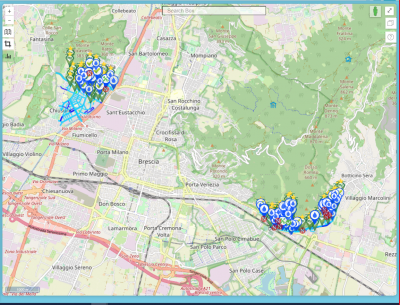
Conclusions
Tullio Montagnoli, CEO A2A Ciclo Idrico: “To reduce water loss, in my opinion, it is essential to be able to identify leaks early on. In Brescia historical city center we have installed a number of 180 sensors to cover 50km of water supply network. A few years ago, we had water losses of 32%, which is under the national average of water loss rates. Now we have reached 28% “
Koen Verweyen, CEO Aquarius Spectrum: “In the heart of Brescia, we’ve not only showcased our technology’s capability but also the synergy of our collaboration with A2A Ciclo Idrico and Pipecare. This project is more than numbers; it’s a testament to the paradigm shift we’re bringing to sustainable water management. At AQS, our mission is to massively reduce the non-revenue-water in existing and future water infrastructures, while protecting the history it flows through. From the UNESCO heritage of Brescia to the sacred streets of Jerusalem, we’re committed to preserving both.”
Nicola Ruggiero, CEO Pipecare: “As partner of Aquarius Spectrum in Italy and long-term trusted service supplier of A2A Ciclo Idrico, we are happy to bring tangible value and innovation in the water industry in Italy. Pipecare is completing the cutting-edge technology of Aquarius Spectrum with its engineering skills, fleet management support, and continuous data analysis. Aquarius Spectrum fits exactly our mission to innovate the water sector and our vision to reduce water losses.”
This initiative showcases AQS’s unique proposition as a provider of high-performance water loss management solutions enriched by a Human-as-a-Service offering. By coupling sophisticated technology with tailored service, AQS is setting a new industry benchmark for cost-effective, sustainable water management.
Aquarius & PUB Case Study – Hydrophone and large diameter pipes solutions
PUB is the national agency managing Singapore’s water loop from catchment through to disposal and reuse. With responsibility for all water management in Singapore, PUB water distribution operations are incentivized to be proactive and manage leakage in their water networks. PUB owns 6,000 kilometers of water pipelines, 1,500 kilometers of which are transmission pipes. 900 hydrophone sensors are deployed on large water mains, up to 2,200mm in diameter. These sensors are designed specifically for underground installation and will perform leak monitoring on approximately 400km of water pipeline. While the sensors are progressively being installed, the benefits can be reaped early without the need to wait till the end of the installation phase.
METHODS
Each night, at an exact predefined time, all the hydrophone sensors record the acoustic profile within the pipe and send the information to a cloud-based server for analysis using a wireless network and algorithms. The results are translated to system alerts including a detailed GIS map of identified leaks and their estimated size. A unique feature of the AQS monitoring system is an automatic correlation between every two measuring sensors, generating reliable and accurate results in a very short of time.
RESULTS
While the system is progressively being installed and the full evaluation of the benefits cannot be accurately determined as yet. However, leaks are progressively being located which allow for early intervention and reduce water loss. Thus far, 15 leaks have been located. Here are just two examples:
A washout valve started to leak through, discharging water into a closed drain. The system was able to locate it early and allow for early intervention. The leak was located near sensor #1:

Once the system identified the leak, an email with the leak location was generated and sent to the local service team Evergloss and to the managing partner STE to continue onsite investigation. At that point Evergloss, equipped with iQuarius mobile solution and a ground microphone went to the alert location and verified it exist.

CONCLUSIONS
A challenge for water utilities is to continually improve their efficiency in the water supply system by reducing water loss experienced in the system. Coupled with global warming and water scarcity, this challenge is exarcebated further. The costs of maintaining pipes that are worn out is high and sometimes require emergency work with higher costs. Water pipes erode unevenly due to environmental conditions, soil, loads and raw material. The ability to identify defective parts in the pipeline in order to replace them and prevent costly maintenance (bursts repairs), water losses and disturbances in the water supply is of great value both to the water corporation and the consumers.
Implementation of technology that provides extensive information on pipeline failures while being repairable or replaceable before damage to infrastructure can significantly save costs in general and water loss in particular. This is a long-term investment that also streamlines the maintenance and management of water assets in the corporation and also increases customer satisfaction while significantly reducing water breaks.

Aquarius and SUEZ New Jersey Case study
SUEZ New Jersey is responsible for supplying drinking water to approximately one million customers in 57 local authorities in New Jersey, USA, operating a water system in the length of 2,200 Miles. SUEZ experienced growth in NRW due to leaks that did not surface.
Technology
Between 2018 and September 2021 SUEZ NJ adopted the Aquarius Spectrum solutions and implemented 2,000 acoustic sensors in New Jersey’s operation. These sensors are permanently installed and monitor the underground pipeline on daily basis, providing accurate location of hidden leaks as well as analysis of the pipeline’s condition to prioritize the replacement of faulty pipeline sections.
Methods
SUEZ NJ shared their history of leak repairs performed in years 2016-2019 so that Aquarius could perform analytics of both the history of breaks along with an analysis of the background leaks they identified through their acoustic sensors. This was to assess the condition of the SUEZ water pipes and direct them to the right failing pipes, so that they optimize their annual replacement budget. In addition, Aquarius monitored the growth rate of background leaks to spot sections with high growth rate, which suggests a poor condition pipe. Aquarius is the only acoustic system that can measure and estimate the size of a leak – hence they can measure how fast they grow. Most leaks will not grow unless the condition of the pipe is poor.
Results
By using Aquarius Leak Detection capabilities, SUEZ NJ located and fixed more than 500 leaks during 2018- 2021, which helped reduce NRW by more than 20% while savings Billion Gallons of Water. By using the new Pipe Condition Module, they were able to identify bad sections that suffered from repeated leaks and fast growth rate of leaks. Today pipe renewal is done by real condition rather than age. Aquarius also supplied SUEZ NJ with predictive maintenance report that included the pipes they need to replace to avoid future catastrophes.
The Impact
- Using Aquarius’ leak detection solution, SUEZ NJ achieved the lowest NRW rates they ever had.
- Using Aquarius’ Pipe Condition Assessment module – Replacement of pipes is not done by age anymore but by failure rates analyzed by the AQS system that uses big data analytics and analysis of leak dynamics. SUEZ moved from being reactive to being proactive and efficient.

Aquarius Case Study in Mei Avivim (The Water Utility of Tel-Aviv) – Multi-sensor
Mei Avivim was established in 2010 by the Tel Aviv-Yafo municipality and entrusted with all the water and sewage services within the city’s area including payment collection. Mei Avivim has 61 km of Transmission mains which re monitored by 87 Aquarius multi-sensors. Aquarius also monitors the connecting distribution lines with 200 additional accelerometer sensors.
Methods
Aquarius multi-sensors consist of hydrophones + pressure sensors to find leaks and pressure transients while transmission from the same electronic box. These sensors were installed on air valves chambers while tapping to the water.
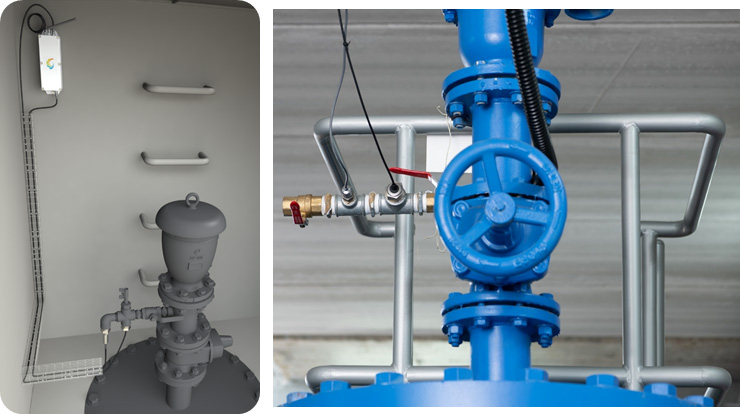
Results
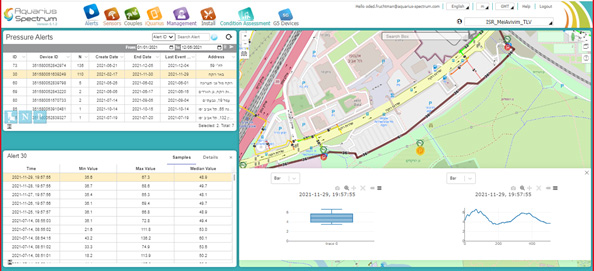
Dozens of transient events detected and fixed during the first year. 7 major leaks identified and repaired.

Aquarius Case Study in Hagihon (The Jerusalem Water Utility): 20% Decrease in NRW and decline in Pipe Bursts
Background
HaGihon – Jerusalem Region Water & Wastewater Utility, is an early adopter of innovative technologies. The Utility’s objectives included increasing consumer satisfaction, decreasing NRW, decreasing energy costs and increasing efficiency. HaGihon water distribution network is spread across the hilly terrain of Jerusalem, requiring the Utility to create multiple pressure zones using water tanks and PRVs. Aquarius Spectrum successfully overcame these challenging conditions during the implementation of the project.
During the two years prior to the implementation of the Aquarius system in Hagihon, there was an increasing trend in the number of bursts per year, which was clearly reversed to a declining trend apparent during the two years in which the Aquarius leak detection system has been in place.
The Solution
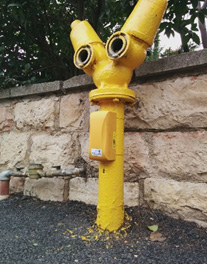 In September 2013, the Utility, together with Aquarius Spectrum, started implementing a fixed water monitoring and leak detection solution. More than 1600 acoustic sensors were installed during 18 months to cover most of the Utility’s water distribution network.
In September 2013, the Utility, together with Aquarius Spectrum, started implementing a fixed water monitoring and leak detection solution. More than 1600 acoustic sensors were installed during 18 months to cover most of the Utility’s water distribution network.
Results
As of August 2016, the Aquarius-Spectrum system has found more than 226 hidden leaks in the Jerusalem area, 171 of which were in the public distribution network and 55 in private properties. Fixing those leaks resulted in potential savings of over a million cubic meters of water for the Utility. NRW was lowered by 18%; the number of visible (reported) leaks (bursts) has declined.
In addition, the Aquarius-Spectrum system has discovered more than 250 non-leak faults, including partially closed valves, faulty water meters, malfunctioning non-return valves and other items of equipment under the responsibility of the water Utility.
Pipe Bursts in Decline
The rising trend in the annual number of pipe bursts was halted and a drop in number is evident since the deployment of the system. See below the numbers, year by year.
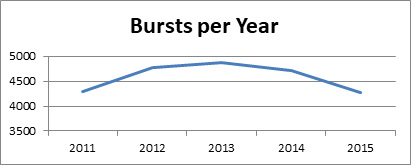
226 Hidden Leaks
As of August 2016, the Aquarius-Spectrum system has found more than 226 hidden leaks that have been repaired by field teams. Without the Aquarius-Spectrum system they would have stayed hidden, causing continuous water loss, or burst into the open at some future date, causing much secondary damages. See the figures in the graph below.
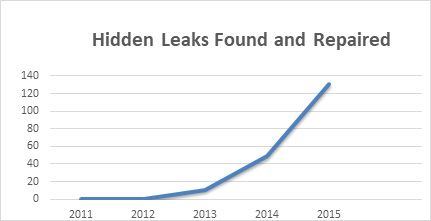
The Aquarius-Spectrum system is helping HaGihon to revolutionize the way it manages leak repairs, allowing it to switch from a reactive mode to a planned approach. The Utility is now able to plan its repair schedule to fix hidden leaks before they become visible bursts, thus reducing the cost of contractors, avoiding collateral damage to infrastructure, informing consumers well in advance of shutting off of water supply for maintenance, reducing shutoff times and improving customer service by notifying consumers of hidden leaks on their premises. All this saves money and improves the level of service.
Aquarius & Thames Water UK Case Study – Mobile Leak Detection
Introduction
Thames Water, is a large private utility company responsible for the public water supply and waste water treatment in most of Greater London, Luton, the Thames Valley, Surrey, Gloucestershire, north Wiltshire, far west Kent, and some other parts of England; it has a considerable local monopoly. Thames Water is the UK’s largest water and wastewater services company and supplies 2.6 billion litres (570 million imperial gallons) of drinking water per day and treats 4.7 billion litres (1,000 million imperial gallons) of wastewater per day. Thames Water’s 15 million customers comprise 27% of the UK population.
In its goal to reduce its NRW rates by 15% as instructed by the UK regulator OFWAT, Thames Water hired 4 service companies to monitor and maintain its pipes. This case study is about 1 quarter which is serviced by Hydro Save and Aqualogic who monitored this area using Aquarius iQuarius™ mobile solutions and found 3,000 leaks.
Methods
Hydro Save and Aqualogic teams surveyed its areas on daily basis. Each IQ team is made of 1 experienced leakage engineer and 3 experienced technicians. Each team has a designated data analyst filtering data and passing POI’s onto the leak engineers for detection and repair. An experienced analysist sifts through 000’s of samples simplifying and speeding up the POI follow up process.
- Night shifts, 20:00 – 06:00 Hrs. 4 shifts per week.
- Working in pairs.
- Technicians use iQuarius 100 to systematically survey all the fittings within the targeted zone (Harvesting Leak Noise):
- Stop taps/Services
- Valves & Hydrants
- Customer meters
- Between 5 and 10 second samples taken and analyzed instantly.
- 300 samples collected per person typically.
- Information automatically synchronized with IQS system.
- Data analyst reviews data checking relevant sound files.
- Filtered POI’s distributed for follow up’s using iQuarius Dashboard
- Experienced leakage engineers follow up all POI’s using iQ-300for correlation and submit to client for repair or follow up.
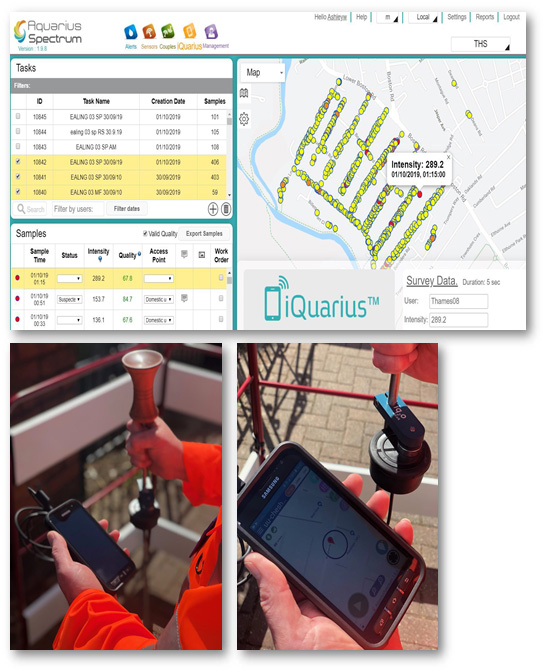
Results
